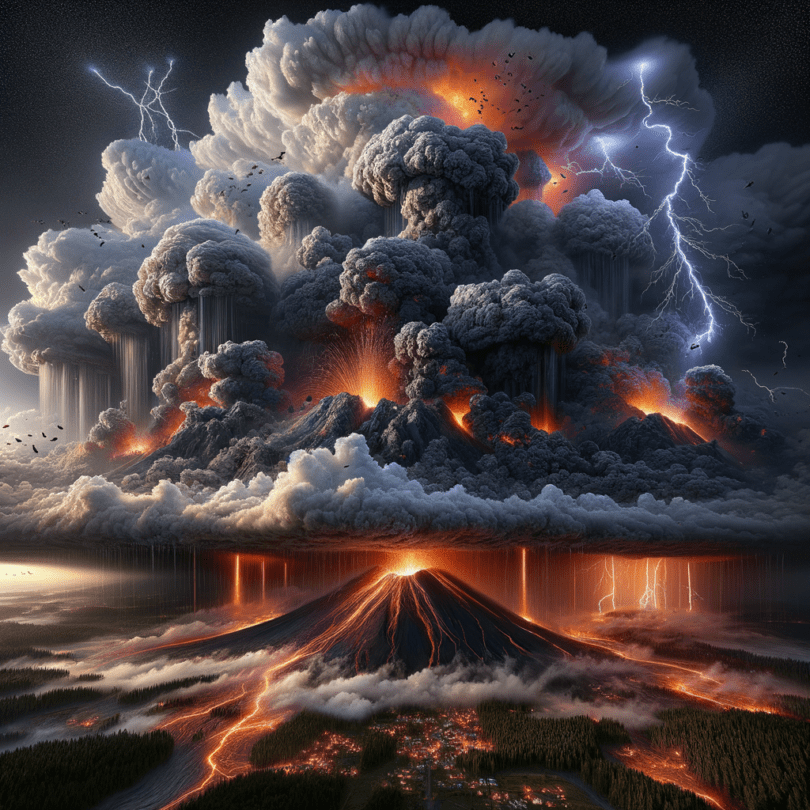The Allure of Volcanoes
You ever just find something completely mesmerizing and can’t let it go? For me, it’s always been volcanoes. They’re like nature’s giant watchmen, ancient and looming, telling tales of creation and chaos. The eruptions are like dramatic fireworks shows, unleashing fiery rivers, dark clouds of ash, and even playing a secret role in whipping up wild weather. Isn’t it just mind-blowing that what happens deep under the ground can tangle with the dance of the stars?
I’m more of a “whiteboard and markers” kind of thinker, so I’ve always wondered: How can something that bursts from the ground cause the sky to cry or storm? You’d think those fiery mountains would mind their own business and stay below their own cloud line, right? Not exactly…
The Veil of Ash
Let’s chew over what happens during an actual eruption. It’s like these volcanoes become dramatic artists, flinging ash and gases high into the sky. But it’s not just any ash—it’s millions of tons of it shooting up there! These particles create a veil, sort of like a massive cloud blanket blocking out the sun, plunging areas into an eerie twilight. This shade can kick off a whole domino effect!
When Mount Pinatubo erupted in the Philippines in 1991, it didn’t just cause local havoc. It shot sulfur dioxide into the stratosphere, wrapping the Earth in a sulfate aerosol blanket. The aftermath wasn’t quick—in fact, the global temperature dropped by about 0.6°C for over a year. Picture it: Earth having a massive, unsolicited “shade party” thrown by a volcano!
Cooling’s Surprising Consequences
You might be thinking, “A little cold doesn’t sound too bad.” But from my side, trust me, it’s not just about grabbing a sweater and some hot cocoa. This cooling can set off quite the chain of events.
The temperature dip can mess with weather patterns. It cools the stratosphere, which then fiddles with jet streams—those speedy air currents high up that steer storms and weather systems. When these streams get wonky, calm weather can ramp up into wild storms. Everything’s connected, like a giant spider web—pull one thread, and you’re bound to see ripples miles away.
And it keeps getting better—or worse, depending on where you are. If some areas cool more than others, pressure changes can whip up new wind systems. These systems might bring heavy rains or bone-dry droughts. I can just picture the weather reporters back then, caught between the thrill of a big story and the gloom of impending chaos.
The Icy Repercussions
What’s truly jaw-dropping are those volcanoes that cause serious wintry scenes. The history books—oh boy!—they tell stories of volcanic winters that mix irony with dread and awe. Take 1816, known as the “Year Without a Summer,” when Mount Tambora’s eruption basically sent the world topsy-turvy. Crops didn’t stand a chance, livestock were freezing left and right, and folks had to cope with snow in the middle of June!
Tambora was a chilling reminder of how vulnerable we are. Isn’t it wild to think an event a whole world away could drape continents in strange weather? Farms failed, food was scarce, and desperation reared its head. It makes you wonder how today’s social media would react if such a thing happened now. Mind-blowing, right?
Sky’s Chemical Chitchat
Volcanoes are not just throwing rocks around; they’re mixing a potent cocktail of gases too. Sulfur dioxide, water vapor, carbon dioxide—all bubbling up in the sky. Especially sulfur dioxide, which turns into teeny tiny sulfate aerosols—think of them as mini sun-blockers, like billions of microscopic umbrellas up there doing a funny little dance.
These changes even mess with the ocean’s state of play, which is like Mother Nature’s conductor for weather systems. The cooling from these aerosols can shift ocean currents, potentially cranking up hurricane power. Now that’s some high-level atmospheric dance-off happening above our heads!
Living with the Unpredictable
Here’s the kicker—we can’t exactly predict when the next big volcanic spectacle will occur or what bag of tricks it might unleash. That kind of unpredictability feels a bit… unnerving, doesn’t it? Living in a world where these fiery behemoths can sway the weather we wake up to each day is both thrilling and slightly terrifying.
Should this be a source of worry? Maybe a smidgeon. But really, staying informed is key. Understanding what’s going on makes us tougher. These eruptions are the Earth reminding us it’s very much alive. They whisper to us to keep wondering, stay ready, and always gaze upward—because nature’s dance is full of beauty and mystery waiting to unfold.
Every dive into this volcanic world fills me with awe and respect, along with a hefty dose of humility. For every storm and disaster tale, there’s a story of perseverance, of humanity standing tall and pushing through the fog. So, how about we tackle these tales with courage and a shared humanity, yeah?

